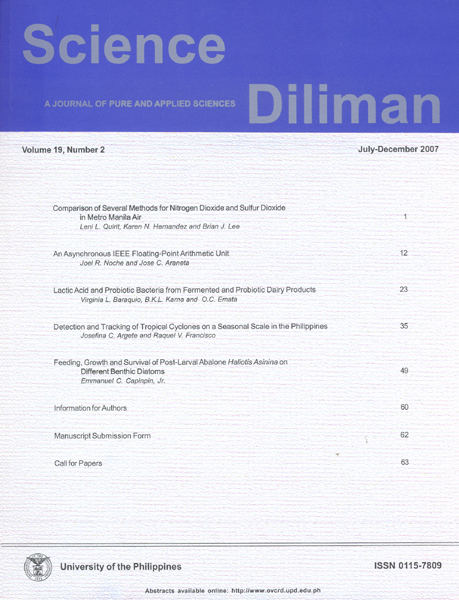Detection and Tracking of Tropical Cyclones on a Seasonal Scale in the Philippines
Abstract
A regional climate model is used to detect tropical cyclones (TC) and simulate their tracks for a four-month (June-July-August-September) wet season in the Philippine region. The model, run at 45-km resolution, is forced along the boundaries with 6-hourly reanalyses data (ERA-40 with about 250-km resolution). Three experiments are devised which varied the size of the domain and placement of the boundaries.A detection and tracking algorithm is developed using 850-mb vorticity threshold, minimum sea level pressure and the presence of a warm core aloft as criteria. The tracks extracted from the ERA-40 field, herein called analyses track, are compared with JTWC best track to test the performance of the tracking algorithm. Of the fourteen (14) TC that entered the domain, ten were formed in the Pacific Ocean and four in the South China Sea. The algorithm detected all TC and skillfully captured the JTWC best track. From the 417 cases (6-hourly positions of the 14 TC), the mean zonal and meridional errors are -164, -23 km, respectively, where the analyses tracks are on the average moving faster westward and southward than the best track. The relatively small magnitude of errors indicates skill of the tracking method.
The regional model is able to detect all 14 TC but with tracks that are farther displaced north of analyses. Simulation of track was enhanced as domain size is decreased. The intensity simulation is improved as more typhoons otherwise not found in the forcing data are generated by the regional model. This study demonstrates that a regional model forced by "perfect" boundary conditions can reasonably simulate the tracks and intensity of tropical cyclones on a seasonal scale. The importance of the use of the proper domain configuration is also shown.
Published
2008-01-15
Issue
Section
Articles
Keywords
regional climate modeling; tropical cyclone tracks
Submission of a manuscript implies: that the work described has not been published before (except in the form of an abstract or as part of a published lecture, review, or thesis); that it is not under consideration for publication elsewhere; that its publication has been approved by all co-authors, if any, as well as by the responsible authorities at the institute where the work has been carried out; that, if and when the manuscript is accepted for publication, the authors agree to the automatic transfer of the copyright to the publisher; that the manuscript will not be published elsewhere in any language without the consent of the copyright holders; that written permission of the copyright holder is obtained by the authors for material used from other copyrighted sources; and that any costs associated with obtaining this permission are the authors’ responsibility.



